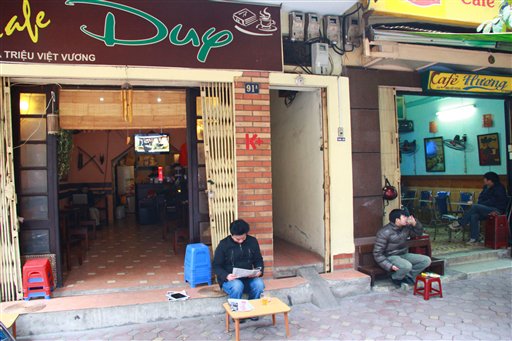By MIKE IVES
Associated Press
HANOI, Vietnam
Nghiem Ngoc Thuy has been slinging coffees to thirsty Vietnamese for 20 years in her colonial-style villa with peeling shutters, and she and her customers aren’t too worried that the imminent arrival of U.S. giant Starbucks will alter their time-tested coffee traditions.
Starbucks announced Thursday that it will open its first cafe in Vietnam early next month in Ho Chi Minh City as part of its strategy to expand across Asia, and plans to add more shops throughout the country.
But compared with other Asian markets Starbucks has recently entered, the Seattle-based company faces a unique scenario in Vietnam, where French-inspired coffee culture reigns supreme, two homegrown chains have established presences and family-run sidewalk cafes are as ubiquitous as noodle shops.
Vietnamese coffee, made from ballsy robusta beans, packs a stronger caffeine wallop than European-style espresso, which is made from effete arabica. It has a slightly bitter taste that usually is offset by sweetened, condensed milk known to rattle tourists’ eyeballs.
Dang Le Nguyen Vu, whose Trung Nguyen Group owns 55 cafes in Vietnam, said he welcomes Starbucks and doesn’t view the American newcomer as a threat.
Unlike China, where tea is the caffeinated drink of choice, Vietnam inherited a coffee culture from French colonizers in the 19th century. Vietnam also is the world’s second-largest exporter of coffee behind Brazil. According to the government, it produced 1.73 million tons of coffee last year, for an export value of $3.7 billion.
Starbucks already operates more than 3,300 stores across 11 countries in the Asia-Pacific region, and its entry into Vietnam marks the latest salvo in a campaign to woo Asia’s emerging middle classes despite a stagnating U.S. economy.
Jinlong Wang, president of Starbucks Asia-Pacific, said the company plans to expand across Vietnam in a way that celebrates the country’s “coffee culture and heritage.”
Vietnam’s economy has slowed recently in part because of a problematic banking sector, but Starbucks’ upmarket brand will appeal to the growing Vietnamese middle class, said Anthony Emms, managing partner at Stanton Emms Strategy Consultants in Singapore, which advises international food and beverage companies on Asian markets.
More than 60 percent of Vietnam’s population was born after the Vietnam War ended in 1975, and there is a strong demand among youth in Hanoi and Ho Chi Minh City for branded clothing and accessories, no matter that the labels often are fakes, and average annual income is only about $1,500.
Other international food chains have opened stores in Vietnam in recent years, including the Australian coffee chain Gloria Jean’s Coffees International, the California-based Coffee Bean & Tea Leaf, and the American fast-food chains KFC and Burger King. And Nestle instant coffee _ engineered to suit the Vietnamese palette _ is sold widely in Vietnamese supermarkets.
But Starbucks would risk alienating some of its potential clients if it didn’t include Vietnamese drip coffee on its menus here, Emms said. “Say you get a grandfather coming in with a younger relative _ he might not want to drink a cafe macchiato or latte,” he said.
Starbucks’ announcement that it is moving into Vietnam has been received without much fanfare in local blogs and state-controlled media, although some speculate about how the company will compete with Trung Nguyen Coffee and Highlands Coffee, a homegrown brand that credits Starbucks as an inspiration.
Nghiem Ngoc Thuy, meanwhile, is still swooping across the worn tiled floors of her cafe, setting down steaming coffees just as fresh customers arrive to order more.
15,000 dong (75 cents) per cup, she said on a recent weekday afternoon, as cigarette smoke curled toward the ceiling. 1,000 extra for condensed milk.
Thuy’s family has been in business since the late 1980s, and watched as this leafy neighborhood _ called “cafe street” by some locals _ has welcomed luxury cars, sushi restaurants and upscale clothing boutiques.
A regular customer, electronics salesman Do Thanh Tung, said he is eager to see if Starbucks coffee really is different from the Vietnamese blends he has been drinking since he was 10 years old.
But he added that he doesn’t expect to become a regular Starbucks patron because he drinks five or six cups of coffee a day, and a latte habit would get expensive.

COMMENTS
Please let us know if you're having issues with commenting.